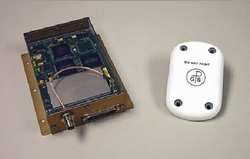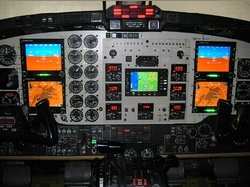Tue, Apr 29, 2003
 FreeFlight Systems announced that its 12-channel,
trans-oceanic-approved GPS sensor, designated the 1201, has
achieved WAAS certification, meeting TSO-C145a Beta Class 1. The
1201 has been selected for the FAA's Capstone program in Alaska.
This program seeks to demonstrate that improving pilots' positional
awareness can substantially reduce accident rates. In this program
the 1201 provides aircraft position and altitude information with
particularly high degrees of accuracy and integrity to the Chelton
Flight Systems' EFIS system (seen below). It also provides a
greatly increased number of approach patterns.
FreeFlight Systems announced that its 12-channel,
trans-oceanic-approved GPS sensor, designated the 1201, has
achieved WAAS certification, meeting TSO-C145a Beta Class 1. The
1201 has been selected for the FAA's Capstone program in Alaska.
This program seeks to demonstrate that improving pilots' positional
awareness can substantially reduce accident rates. In this program
the 1201 provides aircraft position and altitude information with
particularly high degrees of accuracy and integrity to the Chelton
Flight Systems' EFIS system (seen below). It also provides a
greatly increased number of approach patterns.
 WAAS (Wide Area Augmentation System) is an
implementation of differential GPS. It involves corrections to the
position that is computed by an aircraft's GPS receiver by standard
methods, from the data received from the GPS satellites. The
corrections compensate for satellite position errors, and
ionospheric, atmospheric and other conditions. WAAS corrections are
based on the satellite signals received by an array of 26 GPS
groundbased receivers, spread across North America, and situated in
positions that are known with a high degree of precision. Two of
these ground stations act as master stations and compute error
correction values. Correction signals are transmitted via Inmarsat
satellites to receiving aircraft equipped with WAAS-enabled GPS,
and the corrections are applied by the aircrafts' GPS systems.
WAAS (Wide Area Augmentation System) is an
implementation of differential GPS. It involves corrections to the
position that is computed by an aircraft's GPS receiver by standard
methods, from the data received from the GPS satellites. The
corrections compensate for satellite position errors, and
ionospheric, atmospheric and other conditions. WAAS corrections are
based on the satellite signals received by an array of 26 GPS
groundbased receivers, spread across North America, and situated in
positions that are known with a high degree of precision. Two of
these ground stations act as master stations and compute error
correction values. Correction signals are transmitted via Inmarsat
satellites to receiving aircraft equipped with WAAS-enabled GPS,
and the corrections are applied by the aircrafts' GPS systems.
FreeFlight's WAAS is demonstrating lateral navigational
accuracies of better than two meters. It is anticipated that this
performance will lead to approval for precision approach patterns
and Cat II landings to be flown using approved GPS equipment. This
facility would dramatically increase the number of airports and
airfields where IFR approaches are possible, giving GA and
commercial flying operations scope for a substantial increase in
opportunities and flexibility.
 President of FreeFlight, Steve Williams, said,
"This is a major milestone in offering improved safety and
navigation performance in all segments of aviation, increasing the
reliability of operations and opening up countless second-tier
airports, without ILS, to much larger-scale usage. This development
will give a major boost to aviation in the US."
President of FreeFlight, Steve Williams, said,
"This is a major milestone in offering improved safety and
navigation performance in all segments of aviation, increasing the
reliability of operations and opening up countless second-tier
airports, without ILS, to much larger-scale usage. This development
will give a major boost to aviation in the US."
It is anticipated that very noticeable improvements in safety
will occur within days of the widescale installation of WAAS
equipment in the 200 aircraft involved in the Capstone program.
FreeFlight, based in Waco, bought Trimble Navigation's business and
commuter aviation GPS business in 2001. Its professional-standard
GPS are flying in aircraft ranging from 2-seat helicopters to
business jets. The company also produces widely acclaimed radar
altimeters that have been selected by a number of US and European
aircraft manufacturers.
More News
Aero Linx: Model Aeronautical Association of Australia MAAA clubs are about fun flying, camaraderie and community. For over 75 years, the MAAA has been Australia’s largest fl>[...]
Touchdown Zone Lighting Two rows of transverse light bars located symmetrically about the runway centerline normally at 100 foot intervals. The basic system extends 3,000 feet alon>[...]
“Discovery and innovation are central to our mission at Virgin Galactic. We’re excited to build on our successful record of facilitating scientific experiments in subor>[...]
How To Get A Story On Aero-TV News/Feature Programming How do I submit a story idea or lead to Aero-TV? If you would like to submit a story idea or lead, please contact Jim Campbel>[...]
Student Pilot Reported That During Rotation, “All Of A Sudden The Back Of The Plane Kicked To The Right..." Analysis: The student pilot reported that during rotation, “>[...]
 ANN's Daily Aero-Linx (05.02.24)
ANN's Daily Aero-Linx (05.02.24) ANN's Daily Aero-Term (05.02.24): Touchdown Zone Lighting
ANN's Daily Aero-Term (05.02.24): Touchdown Zone Lighting Aero-News: Quote of the Day (05.02.24)
Aero-News: Quote of the Day (05.02.24) ANN FAQ: Contributing To Aero-TV
ANN FAQ: Contributing To Aero-TV NTSB Final Report: Cirrus Design Corp SR20
NTSB Final Report: Cirrus Design Corp SR20




